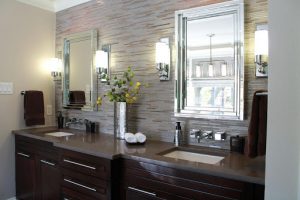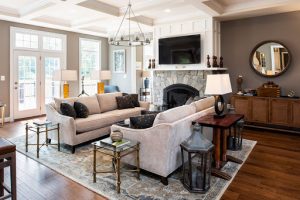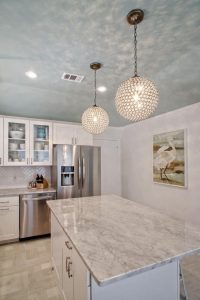Light fixtures are like jewelry: they’re the finishing touch that can make or break an outfit, or in this case your home. Many homeowners spend more time picking out paint colors, furniture & flooring than they do on lighting fixtures or light bulbs. But lighting affects how everything in your home, new or old, looks. It can affect your mood, productivity, even self-image. Think how much happier you feel when you wake up to a bright & sunny day than you feel waking up to cloudy, dreary skies!
After you’ve maximized natural light – the kind that streams in through windows & doors – it’s important to pay attention to how your home is lit when you draw the blinds or when nighttime falls. This can be especially important when finishing a basement since most don’t get a lot of natural light.
The number one lighting mistake: All the lights in the room shine down from above. When the only lighting in a room comes from overhead, the room can seem cold & impersonal. The lights can cast deep shadows on faces – ladies, none of us want that! Solution: Add lighting at head level. What’s “head level” you ask. Depends on the room. In spaces where people tend to stand – entryways, hallways & bathrooms – sconces mounted approximately 5-6 feet up the wall are a great option. Near seating areas in living rooms & family rooms, opt for table or floor lamps that shine light approximately from seated head height.
Mistake: Skipping the sparkle. There are three types of lighting in nature. Ambient light – the general brightness of the daytime sky; focal light – the direct light of the sun; & sparkle – the glimmering light that reflects from bodies of water. While everyone has the first two type of light in their home (ambient from wall reflection & focal direct from fixtures), very few have sparkle in their homes. The glimmering light from sunlight striking water isn’t just pretty to look at, it also stimulates our appetites & offers a sense of well-being. Solution: While attractive anywhere, sparkle is especially good in entryways, dining rooms & kitchen eating areas. A crystal chandelier is a great way to create sparkle, but if that’s too showy for your tastes, any lighting fixture that features faceted glass or a shiny, pebbled metal finish is likely to produce sparkle too. We don’t recommend sparkly lighting in a home office…it’s too distracting.
Mistake: Banishing shadows. Many homeowners assume that shadowy areas are a design problem that they need to fix by adding more or brighter lights. Not the case. Shadows allow us to use light to focus attention where we want it, on a piece of art in an otherwise neutral hallway for example. Shadows also create a sense of depth & dimension in a room, giving it a 3D boost of character. Solution: In most homes, hallways, family rooms & living rooms are most likely to be “over fixtured” – these spaces don’t need to be brightly lit throughout. In a hallway, we need only enough brightly lit areas to see where we’re going. In a family room or living room, we need bright lighting only in the seating & play areas. Not all shadows are beneficial though. You don’t want shadows on faces where people often sit or stand…or in spots where you cook, read or work.
Mistake: Visible light bulbs. If you can see the bulb inside a light fixture from anywhere in the room where you regularly sit or stand – or even a portion of the bulb – that fixture is creating glare that will detract from your enjoyment of the space & your ability to function there. In other words, glare can be annoying. Exceptions – if you can see bulbs through a translucent shade or if they are in a recessed fixture. Solution: Try a smaller bulb that can be hidden from view by the fixture. You can choose a larger shade or try repositioning a floor or table lamp.
Mistake: Overlooking useful spots for lighting. Some rooms in your home may feel like they have the lighting they need. But adding a new fixture can solve problems. Solutions: Bedrooms often have focal lights above the head of the bed for reading, but very few have a focal light positioned above the foot of the bed, where suitcases often are packed & laundry folded. Bathrooms often lack overhead lights above the shower or tub, where they are very useful for shaving & other grooming. A “wet location” fixture is appropriate here. Walk-in closets generally have overhead lights positioned in the center of the ceiling. This not only creates glare if the bulb is uncovered, it leaves items on lower shelves hidden in shadow. The ideal spot? It’s usually directly above the inside of the closet door. This is where you’re least likely to look directly at the light, so it cuts down on glare & where light will shine deepest onto shelves along the far wall. If your closet is extra-large, two or three fixtures is a great idea. Kitchens benefit from under-cabinet lights. But when under-cabinet lighting is located at the back & pointing forward, it may shine in your face when you’re seated. Instead, locate lights at the front, pointing toward the back.
Here at Built by Design, we want all of our projects to be seen in the best possible light. You can count on us to help you choose fixtures that will do just that. Visit our website, http://www.builtbydesignkc.com, to view our project portfolio & submit a Bid Request to get your project quote started.



